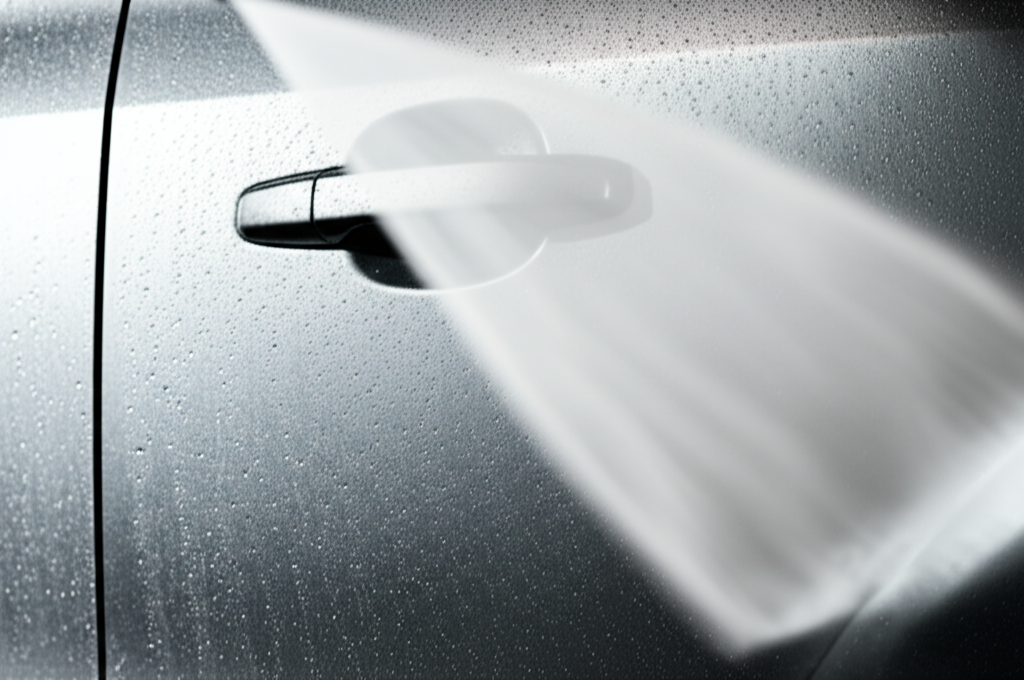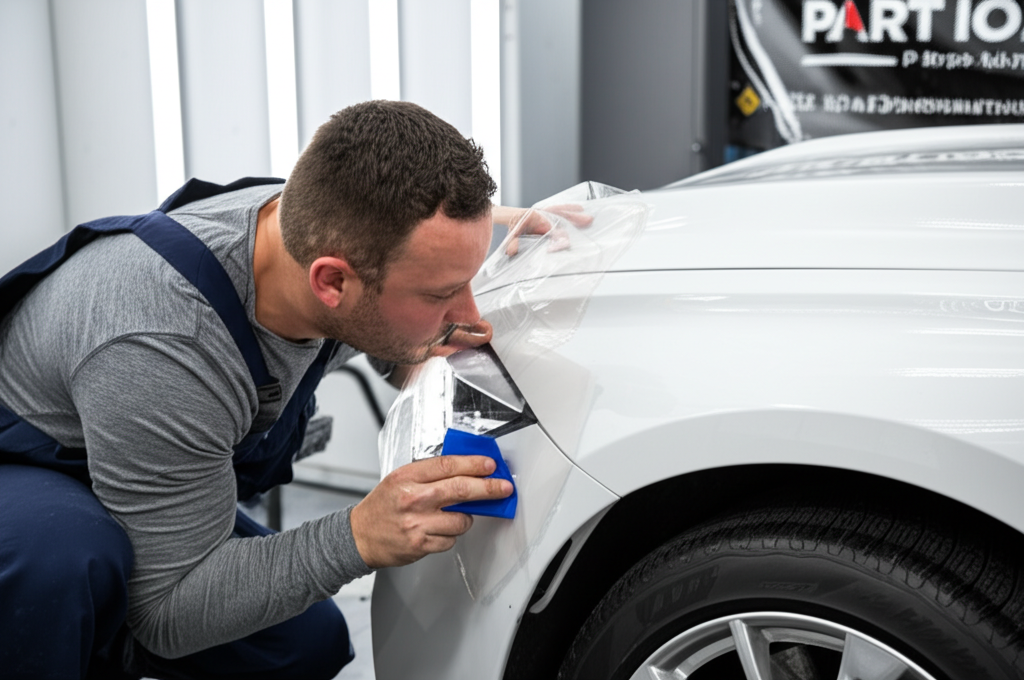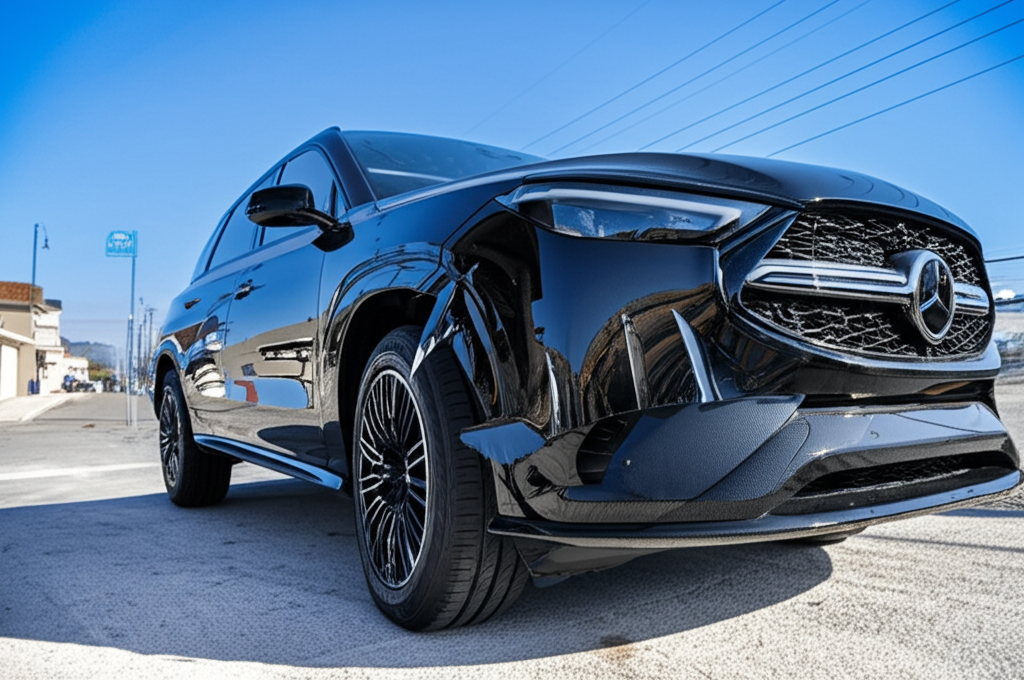You love your car. Truly love it. Keeping it spotless isn’t just a chore; it’s a ritual, a source of pride. Especially here in Thailand, with the dust, the sudden downpours, and the general road grime, maintaining that perfect showroom shine takes dedication. You probably wash your car more often than most, maybe even weekly, meticulously ensuring every speck of dirt is gone. You find satisfaction in the gleaming finish, the way the light reflects off the perfectly smooth paint. But with that dedication comes a nagging anxiety, particularly when it comes to washing. You see the power of that high-pressure water gun at the car wash, and a worry creeps in: could that intense blast, the very tool meant to clean, actually be harming your car’s precious original paint? Could it be causing micro-scratches, or worse, potentially lifting the paint over time? If you’re nodding along, wondering how to reconcile your desire for immaculate cleanliness with the fear of damaging your paintwork, you’re not alone.

Meet Khun Somchai: From Washing Worries to Worry-Free Shine
Let’s talk about Khun Somchai, a Bangkok executive with a brand new, gleaming white BMW 5 Series. Like many meticulous car owners, Somchai was borderline obsessive about keeping his car pristine. He frequented a reputable car wash known for its thoroughness, but he always felt a pang of anxiety watching the attendants wield the high-pressure washer, especially around panel edges and delicate trim. He’d heard stories, seen microscopic swirl marks appear on previous cars despite careful hand washing, and worried constantly about preserving the factory finish he cherished.
His routine involved weekly washes, sometimes more if caught in the rain or after a trip upcountry. This frequency, combined with his fear of the high-pressure spray, started to diminish the joy of owning his dream car. He spent hours researching paint protection options online, initially considering ceramic coatings. While good for gloss and hydrophobicity, he learned they offered limited protection against physical impacts like stone chips or the direct force of a misplaced high-pressure jet.
That’s when he discovered Paint Protection Film (PPF), often called “invisible car bra” or “clear wrap.” Intrigued by its promise of a durable, physical barrier, he visited a highly-rated PPF installation center in Bangkok that specialized in premium films. After a detailed consultation where the installer explained the technology – its thickness, self-healing properties, and resilience – Somchai decided to invest in a full-car wrap using a top-tier, hydrophobic PPF.
The installation process was meticulous, taking a couple of days as trained technicians carefully cleaned, prepped, and applied the film to every panel, ensuring seamless coverage and tucked edges. The change wasn’t just visual – although the car looked even glossier and deeper in colour – it was profoundly psychological. Somchai described it as a “shield of confidence.” Now, when he takes his car for its frequent washes, the anxiety is gone. He knows the PPF layer is taking the brunt, absorbing the impact from the water pressure and protecting the original paint underneath from scratches, swirl marks, bird droppings, bug splatter, and minor road debris. Cleaning is faster too, as the hydrophobic surface sheds water and dirt more easily. His obsession with cleanliness remains, but the fear is replaced by peace of mind.

PPF Decoded: More Than Just a Shine Enhancer
So, what exactly is this Paint Protection Film that gave Khun Somchai his peace of mind back? PPF is a transparent, thermoplastic urethane film applied directly to a vehicle’s painted surfaces. Think of it like a high-tech, invisible suit of armor for your car’s paint. Its primary function is protection against physical damage and environmental contaminants.
How it Protects Against High-Pressure Washing:
This is the core concern for many meticulous owners. High-pressure washers, if used incorrectly (too close, wrong angle, damaged nozzle), *can* potentially cause micro-abrasions or even lift compromised paint edges on unprotected surfaces. PPF provides a robust, resilient barrier. The film itself is typically 6-8 mils (0.15-0.20 mm) thick, significantly more substantial than wax or ceramic coatings. This thickness allows it to absorb and dissipate the energy from the water jet, preventing it from directly impacting and potentially harming the paint layer beneath. While proper washing technique (maintaining a safe distance, avoiding blasting directly at edges) is always recommended even with PPF, the film provides a huge safety margin against accidental damage from high-pressure spray.
Key Benefits of Quality PPF:
- Impact Resistance: Protects against stone chips, gravel, road debris, and minor scuffs. Crucial for Thailand’s varied road conditions.
- Scratch and Swirl Resistance: Many premium PPFs feature a self-healing top coat. Minor scratches and swirl marks (often caused by washing) disappear with exposure to heat (sunlight or warm water).
- Chemical and Stain Resistance: Forms a barrier against bird droppings, bug splatter, tree sap, acid rain, and harsh chemicals, preventing etching into the paint.
- UV Protection: Contains UV inhibitors that prevent the film from yellowing and help protect the underlying paint from fading due to Thailand’s strong sun.
- Enhanced Gloss & Easy Cleaning: High-quality PPF has excellent optical clarity and can enhance the paint’s gloss. Many modern films also have hydrophobic properties, making washing easier and keeping the car cleaner for longer.
PPF vs. Other Protection Methods:
Understanding how PPF stacks up against other popular options helps in making an informed decision:
| Feature | Paint Protection Film (PPF) | Ceramic Coating | Wax / Sealant |
|---|---|---|---|
| Primary Protection | Physical Impact & Scratch Resistance (Stone chips, debris, scratches) | Chemical Resistance & Hydrophobicity (Stains, etching, water beading) | Basic UV Protection & Gloss (Minimal physical/chemical resistance) |
| Material | Thermoplastic Urethane Film | Liquid Polymer (SiO2/SiC) – forms a hard glass-like layer | Natural Carnauba or Synthetic Polymer |
| Durability / Lifespan | 5-10+ years (Premium films) | 2-7+ years (Depending on quality & maintenance) | Weeks to Months |
| Self-Healing (Minor Scratches) | Yes (Most premium films) | No (Some minor resistance to wash swirls) | No |
| Protection Against High-Pressure Wash Damage | Excellent (Provides a thick physical barrier) | Minimal (Layer is very thin, offers little impact resistance) | None |
| Cost (Thailand Market – Estimate) | High (฿50,000 – ฿200,000+ for full car) | Medium (฿10,000 – ฿40,000+) | Low (฿500 – ฿3,000+ DIY or professional) |
| Ideal User | Owners seeking maximum physical protection, especially for new/valuable cars, frequent drivers, or meticulous owners concerned about scratches/chips/wash damage. | Owners prioritizing gloss, ease of cleaning, and chemical resistance, willing to accept less physical protection. Often layered over PPF. | Budget-conscious owners, enthusiasts enjoying frequent reapplications, basic protection needs. |
Peace of Mind: What Fellow Thai Car Owners Say
The true measure of PPF’s value lies in the experiences of those who’ve invested in it. Here’s what some cleanliness-focused car owners in Thailand share:
“I used to inspect my car nervously after every wash, hunting for new swirl marks. Since getting PPF installed on my Mercedes C-Class here in Phuket, that stress is gone. The high-pressure wash doesn’t faze me anymore. Plus, small scratches from roadside bushes just vanished in the sun. Amazing!” – Pim S.
“Driving between Bangkok and Rayong frequently means lots of highway debris. My previous car’s front bumper looked sandblasted after a year. With full PPF on my new Fortuner, it still looks brand new after 18 months. Washing is quicker too. For someone meticulous like me, the investment brings daily peace of mind.” – Mr. Vorachai L.
“My biggest fear was paint damage from the car wash, especially the high-pressure gun. I was hesitant about the cost of PPF, but after seeing a friend’s protected car shrug off a minor parking scuff, I went for it on my Civic Type R. Now, I can enjoy keeping it perfectly clean without the constant worry. It just feels… safer.” – Nattapon K.
Ready to Wash Without Worry?
If you resonate with Khun Somchai’s initial anxiety, if the thought of high-pressure washing potentially harming your pristine paint keeps you up at night, then Paint Protection Film might be the ultimate solution you’re seeking. It’s an investment in preserving your car’s aesthetic appeal, its resale value, and most importantly, your enjoyment and peace of mind as a meticulous owner.
Stop worrying about every wash and start fully enjoying your immaculate vehicle. Explore how premium PPF can provide the robust protection your car deserves in the demanding Thai environment. Contact us today for a consultation and personalized quote.
📱 Want to learn more about car wrap & paint protection?
Feel free to reach us on LINE:

🌐 Official Website: https://tpuwraps.com
Frequently Asked Questions (FAQ)
- Q: Can high-pressure washing really damage original car paint?
- A: Yes, potentially. If the pressure is too high, the nozzle is held too close (less than 12 inches / 30 cm), the angle is incorrect (hitting edges directly), or if the paint is already chipped or peeling, high-pressure water can cause micro-scratches, exacerbate existing damage, or even lift paint flakes. PPF acts as a strong, protective buffer against this risk.
- Q: How long does quality PPF typically last in Thailand’s climate?
- A: Reputable PPF brands offer warranties ranging from 5 to 10 years, sometimes even longer. In Thailand’s conditions (strong UV, heat, humidity), high-quality PPF with proper installation and care (regular washing, avoiding harsh chemicals) should realistically last within this timeframe without significant yellowing, cracking, or peeling.
- Q: Is Paint Protection Film completely invisible?
- A: Modern, high-quality PPF offers exceptional optical clarity and is designed to be virtually invisible when installed correctly by skilled technicians. On some colours or under specific lighting, faint edges might be detectable upon very close inspection, but it doesn’t detract from the overall appearance and significantly enhances gloss.
- Q: Can I apply PPF over a ceramic coating, or vice versa?
- A: PPF should be applied to the bare, properly prepped paint surface for optimal adhesion. Applying PPF over a ceramic coating is generally not recommended as it can interfere with the film’s bond. However, applying a ceramic coating *over* the PPF is a popular option to add extra hydrophobicity and chemical resistance to the film itself.
- Q: What kind of maintenance does PPF require?
- A: PPF maintenance is straightforward. Regular washing using a pH-neutral car soap and the two-bucket method is recommended. Avoid abrasive cleaners or tools. While PPF protects against high-pressure washes, it’s still wise to maintain a safe distance and avoid directly blasting the film’s edges for prolonged periods. Some manufacturers offer specific PPF sealants or detail sprays to maintain its properties.
Invest in Protection, Drive with Confidence
For the car owner obsessed with cleanliness, every wash can be a mix of satisfaction and subtle fear. Paint Protection Film effectively removes that fear, particularly the anxiety surrounding high-pressure washing. It’s more than just a film; it’s a robust shield safeguarding your investment and your passion. By absorbing the daily assaults from road debris, environmental hazards, and even the force of cleaning tools, PPF allows you to maintain that perfect finish without compromise.
Embrace the freedom of frequent, worry-free washing and the confidence that comes from knowing your car’s paint is rigorously protected. Preserve that showroom shine and the joy of driving a pristine vehicle for years to come, no matter how often you feel the need to make it sparkle under the Thai sun.

